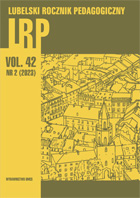OBRAZ POLSKIEJ KSIĄŻKI DZIECIĘCEJ PRZEŁOMU XIX I XX WIEKU
THE IMAGE OF THE POLISH CHILDREN’S BOOK AT THE TURN OF THE NINETEENTH AND TWENTIETH CENTURIES
Author(s): Anna BoguszewskaSubject(s): Social history, Polish Literature, 19th Century, Sociology of Literature
Published by: Wydawnictwo Naukowe Uniwersytetu Marii Curie-Sklodowskiej
Keywords: children’s literature; children’s book; illustration;
Summary/Abstract: Introduction: Polish children’s literature grew out of a close relationship between literature and pedagogy, which took place at the beginning of the nineteenth century, in a difficult political and economic situation for Poles due to the continuation of the partition regime. The cultural development of the nation is connected with the upbringing of the young generation. In the nineteenth century, the Polish book was introduced as a means of education.Research Aim: The aim of the research used in the article was an attempt to reconstruct the image of the Polish children’s book at the turn of the nineteenth and twentieth centuries, taking into account two research problems. They concern the aesthetics and educational messages of reading recommended for the youngest readers. These areas of research are quite sparsely represented. Methods and techniques of historical research were used.Evidence-based Facts: Polish children’s literature developing during the partitions of Poland was studied by a group of Polish researchers: literary scholars, bibliologists, pedagogues and historians of education. However, this research area is unexploited, constituting a rich material for new research searches.Summary: The conducted analyses show that in the years preceding regaining independence, two educational positions dominated children’s literature. The first concerned building a pa- triotic attitude, the second emphasized pragmatism and realism of everyday situations. A num- ber of examples of books for children that confirm these conclusions have been analyzed. The formation of patriotism in children included the transmission of glorious historical pages from the history of the Polish nation, awakening an affirmative attitude to native nature present in key editions for young readers at the turn of the nineteenth and twentieth centuries. Everyday life is presented mainly by images of family, children’s games and instructive stories, adventures from the life of peers. The aesthetics of the children’s book of the discussed period fits into the style in force at that time, based on the pursuit of a masterful typographic arrangement. The uniqueness of the illustrations, especially colorful, as can be assumed, were a strong reinforce- ment of the impact of the message.
Journal: Lubelski Rocznik Pedagogiczny
- Issue Year: 42/2023
- Issue No: 2
- Page Range: 225-239
- Page Count: 15
- Language: Polish

